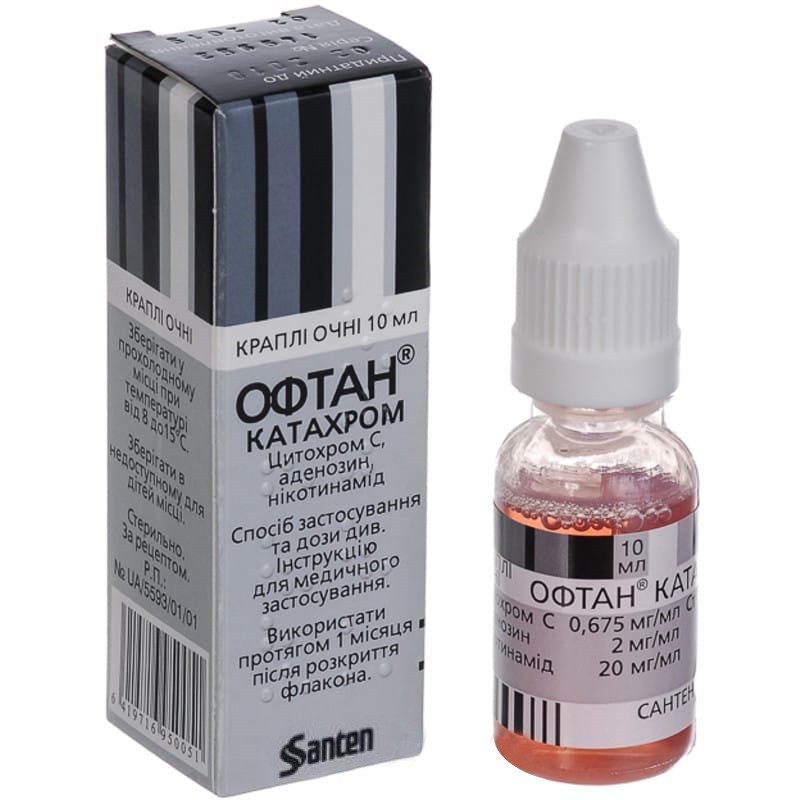



 Secure and encrypted payment processing
Secure and encrypted payment processing We ship to over 40 countries including the USA, UK, Europe, Australia and Japan
We ship to over 40 countries including the USA, UK, Europe, Australia and Japan Guaranteed refund or reship if you haven't received your order
Guaranteed refund or reship if you haven't received your orderCataract Treatment the mechanism of action of the drug is primarily due to the antioxidant and trophic effect of the active components included in its composition - cytochrome c, adenosine and nicotinamide.
Cytochrome C is a high molecular weight iron porphyrin compound. It is a conjugated protein whose structure is close to that of hemoglobin. Cytochrome C plays a crucial role in redox processes in almost all aerobic organisms due to the reversible change in the valency of iron contained in cytochrome - with Fe2+ on Fe3+ and back. These reactions occur with the participation of two mitochondrial enzymes - cytochrome oxidase and cytochrome reductase. Hem - the active component of cytochrome C - can act as a donor or acceptor of electrons. It has a high utilizing activity against free oxygen radicals. It was found that with cataracts, the concentration of cytochrome C in the lens decreases. Cytochrome C cannot penetrate into the cornea in sufficient quantities as a whole molecule, this becomes possible only after cleavage of the peptide chain. The heme-containing nonapeptide penetrates freely into the cornea. Inhibition of oxidative processes in all tissues located in front of the lens (cornea and intraocular fluid) is important to suppress the development of cataracts, since ultraviolet radiation causes chain reactions in these tissues with the formation of radicals, which, as a rule, can lead to clouding of the lens. The heme-containing cytochrome C, which is part of Oftan Katachrome eye drops, has the ability to neutralize oxygen radicals in certain redox reactions and thus can prevent the development of cataracts caused by free radicals.
Adenosine consists of adenine and D-ribose and is the main component of ATP. Adenosine is also part of the cAMP molecule, the coenzyme molecule FAD (flavin adenine dinucleotide), NAD (nicotinamide adenine dinucleotide) and NADP (nicotinamide adenine dinucleotide phosphate). In most cases, the development of cataracts is due to degeneration of the lens. DNA repair in the epithelium of the crystalline lens is necessary for the restoration of disorders caused by the damaging effects of oxidation processes. Adenosine is a necessary component for the synthesis and repair of DNA and RNA, as well as a structural element of these molecules. In addition, adenosine acts as a paracrine regulator.
Thus, adenosine, which is part of Oftan Catachrom eye drops, has many effects: it is a trophic agent and the main element for DNA repair and energy metabolism; promotes leaching of toxic decay products, stimulating the production and exchange of intraocular fluid due to vasodilation and increased blood supply to the eye; reduces the severity of inflammation in the conjunctiva, cornea and other tissues of the eye, and also indirectly affects the restoration of glutathione, since it is a structural element of the enzyme glutathione reductase and reduced NADP, which provide antioxidant protection.
Nicotinamide is a structural element of the vital coenzymes NAD and NADP. The action of this component is aimed at enhancing the regeneration of the endothelial cells of the lens. In the body, it is cleaved by nicotinamidase to form nicotinic acid.
The active components of the drug are substances of endogenous origin. Cytochrome C consists of heme and a single peptide chain (apocytochrome C). The cytochrome C molecule penetrates into the cornea only after cleavage of the peptide chain to a heme-containing nanopeptide. When applied topically, it does not enter the systemic circulation. The heme after penetration into the cornea is evenly distributed in the tissues.Characterized by lipophilicity and hydrophobicity, being associated with a peptide chain or globin (hemoglobin), acquires hydrophilic properties. Cytochrome C is completely metabolized in the body. Apocytochrome C is metabolized in the same ways as amino acids, and the heme breaks down to bilirubin, which is excreted with bile.
Adenosine consists of purine (adenine) and sugar (D-ribose). When applied topically, it freely penetrates the cornea and is distributed in the tissues. The elimination half-life is less than 1 hour. It is metabolized in almost all body tissues with the formation of inosine, xanthine, and ultimately urate, which is excreted in the urine. Ribose is metabolized with the participation of transketolase to glyceraldehyde-3-phosphate, and then to pyruvate, which is used in the Krebs cycle.
Cataract.
1-2 drops 3 times a day in the affected eye.
Hypersensitivity to any of the components of the drug.
Short-term burning sensation in the eye, rarely - contact allergic conjunctivitis and blepharitis. possible systemic side effects of the drug include nausea, arterial hypotension, dizziness, and shortness of breath.
The preparation contains benzalkonium chloride as a preservative, which can be deposited on soft contact lenses; therefore, before instilling the drug, they should be removed and worn no earlier than 15 minutes later.
Clinical data on the effectiveness and safety of the drug in children, as well as during pregnancy and lactation are insufficient.
The drug contains endogenous substances that are rapidly metabolized in the body, so an overdose is unlikely. if necessary, symptomatic therapy is prescribed.
At a temperature of 8-15 ° C. after opening the bottle, the solution must be used within 1 month.